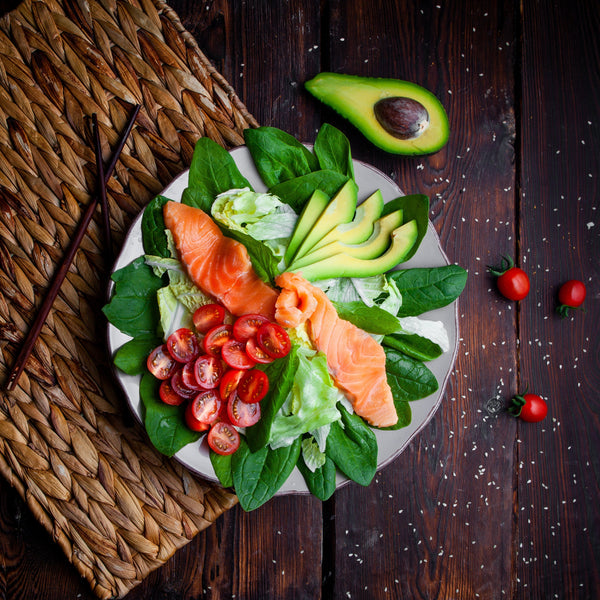Top 10 Benefits of Following a Paleo Meal Plan
by JUSTINE YOLANDA

Introduction
In a world filled with processed foods, artificial additives, and hidden sugars, many people are searching for a simpler, healthier way to eat. Whether your goal is weight loss, increased energy, or overall well-being, the right diet plays a crucial role. This is where the meal plans come in—a way of eating that focuses on whole, natural foods and eliminates heavily processed ingredients.
The Paleo diet is inspired by how our ancestors ate, emphasizing lean proteins, fresh vegetables, fruits, nuts, and healthy fats while cutting out refined sugars, grains, and processed foods. The idea is simple: eat real food, just as nature intended, to support your body’s natural functions.
But why should you consider going Paleo? What benefits can it offer? In this blog, we’ll explore ten science-backed advantages of following a Paleo meal plan from boosting energy and supporting digestion to improving heart health and reducing inflammation. By the end, you’ll understand how adopting this lifestyle can transform your health for the better.
Let’s dive in.
What is a Paleo Meal Plan?
A Paleo meal plan is based on the idea of eating whole, unprocessed foods that our ancestors consumed thousands of years ago. The diet eliminates modern processed foods and focuses on natural, nutrient-dense ingredients that support overall health. The goal is to eat in a way that aligns with our evolutionary biology, reducing inflammation, stabilizing blood sugar, and improving digestion.
Key Components of a Paleo Meal Plan
A well-balanced Paleo diet includes:
-
Lean meats (grass-fed beef, chicken, turkey)
-
Fish and seafood (wild-caught salmon, tuna, shrimp)
-
Fresh vegetables (leafy greens, broccoli, carrots, bell peppers)
-
Fruits (berries, apples, oranges, bananas)
-
Nuts and seeds (almonds, walnuts, flaxseeds, chia seeds)
-
Healthy fats (avocado, coconut oil, olive oil)
Foods excluded from a Paleo diet include processed grains, dairy, refined sugar, and artificial additives. The emphasis is on minimally processed foods that provide essential nutrients without harmful chemicals or preservatives.
Common Misconceptions
Many people believe Paleo is just about eating large amounts of meat, but this is not true. The diet prioritizes a balanced intake of proteins, healthy fats, and plant-based nutrients. Another myth is that the Paleo diet is too restrictive, but with a variety of whole foods available, it offers plenty of flexibility and delicious meal options.
By focusing on whole, natural ingredients, a Paleo meal plan can help improve overall health while promoting sustainable eating habits.
Top 10 Benefits of Following a Paleo Meal Plan
1. Promotes Natural Weight Loss
The Paleo diet naturally supports weight loss by focusing on high-protein, low-carb foods that keep you full and boost metabolism. Unlike restrictive diets, it eliminates processed foods, reducing cravings and overeating.
-
High protein intake increases satiety and helps preserve muscle mass.
-
The low-carb approach helps the body burn fat more efficiently.
-
Whole food-based eating has been linked to long-term fat loss in studies.
Takeaway: By cutting out processed foods and focusing on nutrient-dense meals, Paleo makes it easier to achieve and maintain a healthy weight.
2. Reduces Inflammation
Chronic inflammation is linked to various health issues, including heart disease, diabetes, and autoimmune disorders. The Paleo diet removes inflammatory foods like refined sugars and seed oils, replacing them with anti-inflammatory choices.
-
Processed foods contribute to inflammation, leading to joint pain and fatigue.
-
Paleo emphasizes anti-inflammatory foods, such as fatty fish, berries, and leafy greens.
-
Studies show Omega-3 fatty acids (abundant in Paleo foods) help combat chronic inflammation.
Takeaway: The Paleo diet’s focus on whole, nutrient-dense foods helps reduce inflammation and support overall well-being.
3. Improves Digestion & Gut Health
Many people experience bloating, gas, and digestive discomfort due to highly processed foods, grains, and dairy. Paleo eliminates these common irritants and encourages gut-friendly nutrients.
-
No dairy or grains reduces bloating and digestive distress.
-
Increased fiber intake from vegetables and fruits supports a healthy gut.
-
Fermented foods and natural probiotics (like sauerkraut and kimchi) enhance gut bacteria balance.
Takeaway: Paleo supports a healthy digestive system by eliminating irritants and promoting gut-friendly foods.
4. Balances Blood Sugar & Reduces Cravings
Refined sugars and processed carbs cause blood sugar spikes and crashes, leading to energy dips and cravings. The Paleo diet helps stabilize glucose levels by prioritizing nutrient-dense foods.
-
No refined sugars means more stable energy throughout the day.
-
High protein and healthy fats curb sugar cravings.
-
Low glycemic index foods help prevent insulin resistance.
Takeaway: By eliminating processed sugars and refined carbs, Paleo helps keep energy levels steady and cravings under control.
5. Increases Energy Levels
Many people report feeling more energized after switching to Paleo. This is because the diet removes energy-draining foods and replaces them with nutrient-dense options.
-
No refined sugars = No energy crashes.
-
Healthy fats and proteins provide sustained energy.
-
Nutrient-dense foods support cellular function and metabolism.
Takeaway: Paleo provides long-lasting energy by focusing on whole foods that fuel the body efficiently.
6. Supports Muscle Growth & Strength
Whether you’re an athlete or just want to maintain a strong body, Paleo is rich in protein and essential nutrients that promote muscle development.
-
High-protein intake supports muscle repair and growth.
-
Healthy fats and micronutrients aid recovery and performance.
-
Eliminating inflammatory foods helps prevent muscle fatigue and joint pain.
Takeaway: Paleo supports muscle health and physical performance, making it ideal for active individuals.
7. Enhances Mental Clarity & Focus
Unstable blood sugar levels and processed foods can cause brain fog, sluggishness, and difficulty concentrating. Paleo promotes brain health with nutrient-rich, anti-inflammatory foods.
-
No blood sugar spikes = More stable brain function.
-
Healthy fats like Omega-3s support cognitive function.
-
Eliminating processed food toxins improves mental clarity.
Takeaway: A Paleo diet sharpens focus, reduces brain fog, and supports long-term brain health.
8. Promotes Heart Health
Paleo eliminates unhealthy trans fats and refined sugars—two major contributors to heart disease—while prioritizing heart-friendly nutrients.
-
Healthy fats from nuts, seeds, avocados, and fish support cardiovascular function.
-
No processed oils or trans fats reduces risk of heart disease.
-
Anti-inflammatory foods help maintain optimal blood pressure and cholesterol levels.
Takeaway: Paleo supports a strong and healthy heart through natural, whole foods.
9. Strengthens the Immune System
A strong immune system starts with proper nutrition, and Paleo is packed with immune-boosting vitamins and minerals.
-
Nutrient-dense foods supply essential vitamins like C, D, and zinc.
-
A healthy gut (supported by Paleo) is directly linked to immunity.
-
Antioxidant-rich foods reduce oxidative stress and strengthen defense mechanisms.
Takeaway: Paleo provides key nutrients to keep your immune system resilient and ready to fight infections.
10. Encourages a Sustainable, Healthy Lifestyle
Unlike fad diets, Paleo is not a temporary fix—it’s a long-term approach to better health.
-
Encourages home cooking and mindful eating.
-
Eliminates the need for calorie counting by focusing on real food.
-
Helps build a healthier relationship with food through natural, satisfying meals.
Takeaway: Paleo is more than a diet it’s a sustainable lifestyle that promotes long-term health and wellness.
How to Get Started with a Paleo Meal Plan
Starting a Paleo meal plan doesn’t have to be overwhelming. By making gradual changes and focusing on whole, natural foods, you can transition smoothly into a Paleo lifestyle.
Practical Tips for Beginners
-
Clean out your pantry – Remove processed foods, refined sugars, and grains.
-
Stock up on Paleo-friendly foods – Fresh vegetables, lean meats, nuts, and healthy fats.
-
Plan your meals – Having a meal plan helps avoid unhealthy choices.
-
Read labels carefully – Hidden sugars and preservatives are common in packaged foods.
Simple Swaps to Make
-
Replace sugary snacks with nuts, seeds, or fresh fruit.
-
Swap processed cooking oils for olive oil, coconut oil, or avocado oil.
-
Use cauliflower rice instead of white rice for a grain-free alternative.
-
Opt for lettuce wraps instead of bread for sandwiches.
Quick Paleo Meal Example
Grilled chicken with roasted vegetables (zucchini, bell peppers, and carrots) and sliced avocado for a healthy dose of fats.
By making small, manageable changes, you can easily adapt to a Paleo lifestyle and enjoy the long-term health benefits it offers.
Common Myths About Paleo
Despite its popularity, the Paleo diet is often misunderstood. Let’s debunk some of the most common myths.
Myth #1: “Paleo is just about eating meat.”
False. While the Paleo diet includes lean meats and fish, it also emphasizes vegetables, fruits, nuts, and healthy fats. In fact, plant-based foods make up a significant portion of a well-balanced Paleo meal plan. The focus is on whole, unprocessed foods, not just meat.
Myth #2: “Paleo is too expensive.”
Not necessarily. While organic meats and fresh produce can be costly, Paleo doesn’t have to break the bank. You can keep costs down by:
-
Buying seasonal and local fruits and vegetables.
-
Choosing budget-friendly protein sources like eggs and canned fish.
-
Shopping in bulk for nuts, seeds, and pantry staples.
Myth #3: “Paleo lacks variety.”
Far from it. Paleo includes a diverse range of foods, from colorful vegetables and fresh fruits to flavorful herbs and spices. There are countless creative meal ideas, such as:
-
Zucchini noodles with pesto and grilled chicken.
-
Stuffed bell peppers with ground turkey and spices.
-
Almond flour pancakes with fresh berries.
By understanding the true principles of Paleo, it becomes clear that it’s a nutrient-rich, flexible, and sustainable way of eating.
Conclusion and Final Thoughts
The Paleo meal plan is more than just a diet, it's a sustainable lifestyle that prioritizes whole, nutrient-dense foods. By eliminating processed ingredients and focusing on lean proteins, healthy fats, and fiber-rich vegetables, Paleo can support weight loss, improved digestion, stable energy levels, and overall well-being.
If you’re new to Paleo, start small. Simple swaps like replacing processed snacks with nuts and fruit or using cauliflower rice instead of white rice can make the transition easier. Focus on gradual changes rather than perfection.
Ultimately, Paleo isn’t about restriction, it's about fueling your body with real, nourishing foods. Whether your goal is better digestion, weight management, or increased energy, a Paleo meal plan can be a great step toward a healthier lifestyle.




